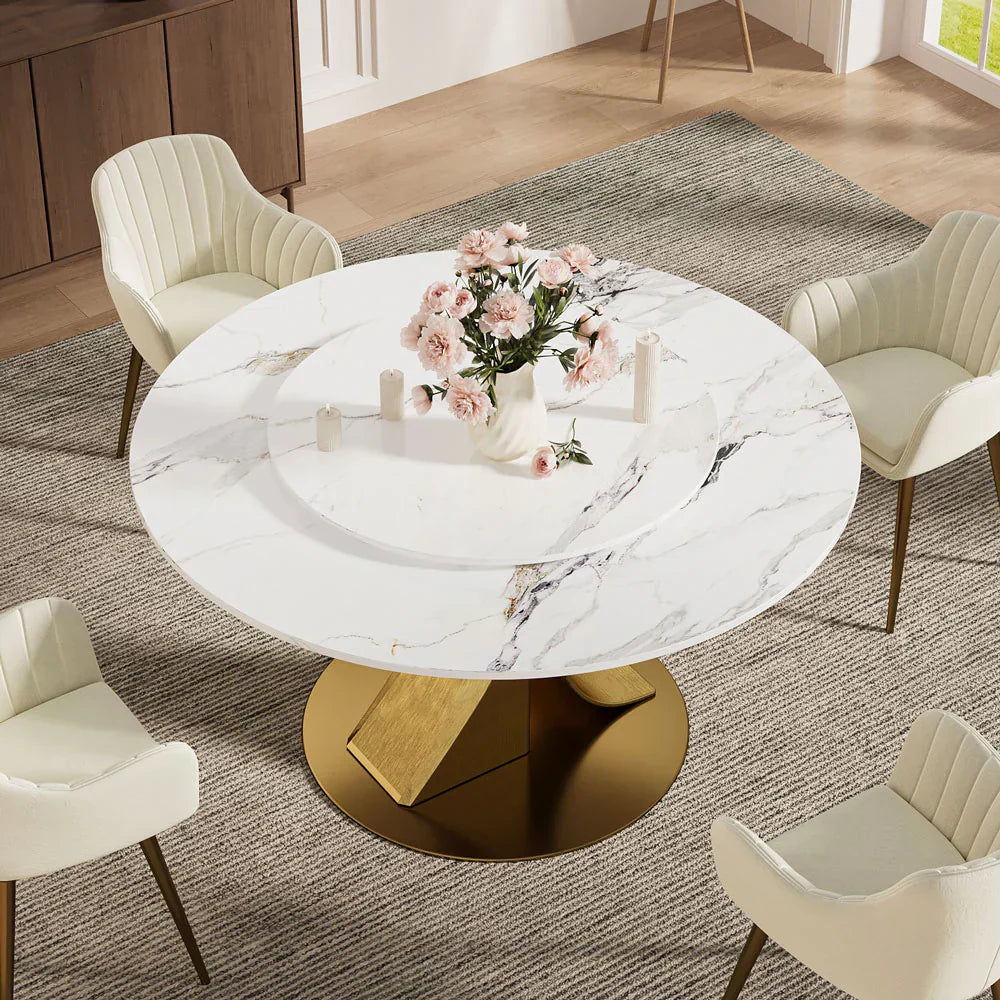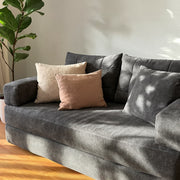
Scratch-Resistant Dining Tables: Expert Tips & Top Picks for Your Home
- Tabitha Crawley
- 2025
A dining table should look beautiful and withstand daily life. For many buyers, the top concern when choosing a table is durability — especially resistance to scratches from cutlery, dishware, or everyday use. This guide focuses on scratch resistant dining tables, with an emphasis on stone dining tables (natural and engineered), and explains how to choose a table that balances toughness, style, and maintenance.
What “Scratch-Resistant” Really Means
“Scratch-resistant” describes a surface’s ability to resist visible abrasion and maintain finish under routine contact. Resistance depends on two factors:
-
Surface hardness and construction — harder, denser materials (e.g., granite, sintered stone) withstand abrasion better.
-
Protective finishes and fabrication — seals, glazes, and manufacturing processes (like sintering) enhance scratch and stain resistance.
Understanding these fundamentals helps you compare materials objectively rather than relying on buzzwords.
Stone Dining Tables — Why They Lead the Category
Stone surfaces combine high hardness, heat resistance, and low porosity — properties that directly reduce scratches and stains. Within stone options, differences matter for durability and upkeep.
Below, we explore three main types — Natural Stone, Engineered Stone, and Porcelain & Ceramic Composites — so you can choose the right one for your lifestyle and aesthetic.
Natural Stone: Marble, Granite, Travertine
-
Granite: Very hard and highly scratch-resistant; ideal for heavy daily use. Minimal maintenance beyond occasional sealing.
-
Marble: Striking veining and luxury look; softer than granite and more prone to etching and visible marks. Suitable where aesthetics are prioritized and light care is acceptable.
-
Travertine: Softer stones with beautiful texture, ideal for a natural, earthy aesthetic but requiring more care to prevent stains or chips.
Verdict: For pure scratch resistance among natural stones, granite is generally preferable; marble favors appearance over absolute toughness.
Engineered Stone: Quartz & Sintered Stone
Engineered stone represents the next generation of performance materials — designed to capture the beauty of natural stone with superior resistance to scratches, stains, and impact.
-
Quartz (Artificial Stone) — Made from crushed quartz crystals mixed with resin, it offers excellent scratch resistance, low porosity, and a consistent surface pattern. However, it’s not fully heatproof and can discolor with prolonged UV exposure.
-
Sintered Stone (Ultra-Compact Surface) — Created through advanced sintering technology that fuses natural minerals under extreme heat and pressure.
Unlike quartz, it contains no resin, making it fully heat-resistant, UV-stable, and virtually scratch-proof. Its ultra-dense surface is ideal for dining tables that need to withstand everyday wear — from hot plates to cutlery marks.
Note: While sintered stone and porcelain slabs share some similarities in manufacturing, they are not the same. Sintered stone is engineered with a more complex mineral composition and processed under higher pressure and temperature, resulting in a denser, stronger surface specifically designed for high-performance furniture and countertops.
Verdict: Sintered stone dining tables are currently one of the best choices for households seeking both luxury aesthetics and true scratch resistance.
Porcelain Slabs (Large-Format Ceramic Composites)
Large-format porcelain slabs have become a popular choice in contemporary dining furniture. These surfaces are made from refined clay, feldspar, silica, and natural oxides, then fired at extremely high temperatures to create a dense, fully vitrified, and entirely nonporous surface.
They offer several standout benefits:
-
Superior resistance to scratches, stains, and heat.
-
Extensive design flexibility, available in matte, gloss, textured, and highly realistic marble or wood-look finishes.
Verdict: Porcelain slabs can be slightly more brittle than sintered stone, especially along the edges. This means professional handling and proper protective packaging are essential during delivery and installation to prevent chipping. When installed correctly, however, porcelain slabs deliver a refined, durable, and visually striking dining surface.
Other Materials — When They Make Sense
While stone excels for scratch resistance, these alternatives have their merits:
-
Hardwood (oak, walnut): Durable and warm in appearance. High-density hardwood resists light scratches but can dent; requires sealing and occasional refinishing for long life.
-
Tempered Glass: Scratch-resistant in many respects and heat tolerant, though micro-scratches and smudges can show; pairs well with minimalist, modern interiors.
-
Metal or Powder-Coated Tops: Long lifespan and industrial aesthetic; surface marks may become part of the patina and can be refinished in some cases.
Choose these when you prioritize aesthetics, weight, or a particular design language; for maximal scratch resistance, stone remains superior.
How to Choose the Right Scratch-Resistant Dining Table
Use this practical checklist to match material and design to your household needs.
1. Match material to use case
-
Frequent family meals, kids, or rentals: prioritize sintered stone or quartz for minimal maintenance.
-
High-end aesthetic with moderate use: granite offers durability and natural character.
-
Occasional use or formal dining: marble can be appropriate with careful care.
2. Size and shape considerations
Measure room clearance (at least ~36 in / 90 cm around the table) and account for chair pullback. Round tables save space and encourage conversation; rectangular tables suit longer rooms and larger gatherings.
3. Base and stability
Stone tops are heavy. Ensure the base design distributes weight evenly — metal or reinforced wooden bases are common. Look for strong joinery and anti-tilt features.
4. Finish and edge profiles
Polished finishes show scratches differently than honed or matte surfaces. Edge profiles (beveled, bullnose) influence chip resistance. For heavy use, prefer matte or textured finishes that hide minor marks better.
5. Delivery and installation
Check access for delivery and installation: heavy stone tops may require disassembly or special handling. Plan routes through doorways and staircases in advance.
Top Picks for Scratch-Resistant Dining Tables
Here are three Arrtle selections that illustrate different stone approaches and design priorities:
1. Round Sintered Stone Dining Table Scratch Resistant

Elevate your dining room with this round table featuring a sintered stone tabletop that captures the elegance of marble while standing up to scratches, stains, and heat. Its gold stainless steel base provides stability and a touch of contemporary flair. The smooth surface is simple to maintain, making it a practical yet luxurious centerpiece for both everyday meals and special occasions.
Key Specs:
-
Dimensions: 51.2 inches diameter × 29.5 inches height
-
Materials: Sintered Stone tabletop + Stainless Steel gold base
-
Style Options: Table only / Table with 4 chairs / Table with 6 chairs
-
Durability: Scratch-resistant, stain-resistant, and easy to maintain
-
Assembly: Partial assembly required (approx. 45 minutes)
-
Packaging Weight: 85 kg
-
Return Policy: 60-day return window for refund; free returns for defective or incorrect items; buyer pays shipping for non-defective returns; no restocking fees
2. Modern Dining Table with Ceramic Stone Top

This table blends a ceramic stone top with a solid wooden base, offering a balance of elegance and practical durability. Its minimalist design complements both modern and traditional interiors, while the smooth surface resists scratches and stains. Spacious enough for family meals or casual entertaining, this table brings understated sophistication to any dining space.
Key Specs:
Dimensions: 63" L × 31.5" W × 29.5" H / 71" L × 31" W × 30" H
Materials: Ceramic Stone tabletop + Solid Wood base
Style Options: Table only / Table with 4 chairs / Table with 6 chairs
Assembly: Partial assembly required (approx. 45 minutes)
Packaging Weight: 62 kg
Return Policy: 60-day return window for refund; free returns for defective or incorrect items; buyer pays shipping for non-defective returns; no restocking fees
3. Round Lazy Susan Dining Table with Marble-Effect Tabletop

Make every meal more convenient with this marble-effect sintered stone table, featuring a rotating Lazy Susan for easy sharing. The gold metal base adds modern elegance, while the generous round design accommodates 4-6 people comfortably. Ideal for gatherings or family dinners, it merges functional design with a sophisticated look that enhances any dining room.
Key Specs:
Dimensions: 58.5" diameter × 29.2" height
Materials: Sintered Stone tabletop + Gold Metal base
Style Options: Table only / Table with 4 chairs / Table with 6 chairs
Assembly: Partial assembly required (approx. 45 minutes)
Packaging Weight: 80 kg
Return Policy: 60-day return window for refund; free returns for defective or incorrect items; buyer pays shipping for non-defective returns; no restocking fees
Each of these tables delivers practical scratch resistance without compromising on style. Whether you prefer the luxurious marble-like elegance of sintered stone, the versatile minimalism of ceramic stone, or the family-friendly functionality of a Lazy Susan, these dining tables help you create a space that is both beautiful and durable.
Care & Maintenance — Keep It Looking New
Even scratch-resistant tables benefit from reasonable care:
-
Daily wipe: use a soft, damp cloth; avoid abrasive pads.
-
Immediate cleanups: remove acidic spills (e.g., vinegar, wine) promptly to prevent etching on sensitive stones.
-
Protective use: placemats, trivets, and coasters prevent concentrated pressure and thermal shock.
-
Sealing (natural stone): if using marble or travertine, apply a recommended sealer per manufacturer guidance (typically every 6–12 months).
-
Avoid harsh cleaners: alkaline or acidic cleaners can damage finishes — use pH-neutral cleaners recommended for the material.
Following these simple habits prolongs surface integrity and preserves appearance.
Final Recommendations
If your top priority is resistance to scratches and everyday stains — especially with active family life — sintered stone and engineered quartz are the most practical choices. Granite is an excellent natural option when you want real stone hardness; marble offers unmatched beauty but requires more care.
When selecting a model, consider how often the table will be used, whether it needs to be moved, and the delivery constraints. Finally, pair the top material with a sturdy base and choose a finish that masks minor wear while delivering the aesthetic you want.

